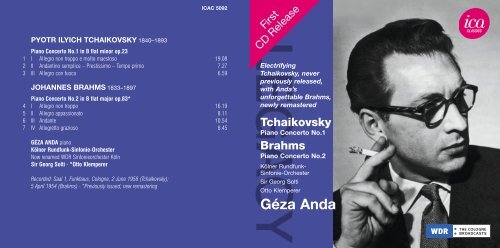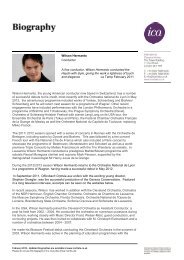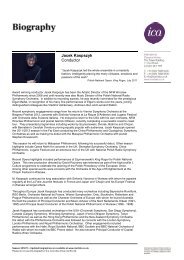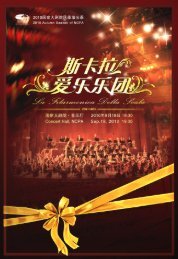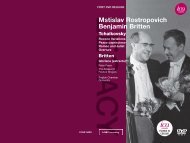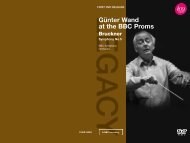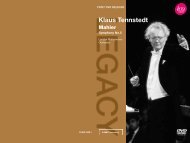to download - International Classical Artists
to download - International Classical Artists
to download - International Classical Artists
Create successful ePaper yourself
Turn your PDF publications into a flip-book with our unique Google optimized e-Paper software.
ICAC 5092<br />
PYOTR ILYICH TCHAIKOVSKY 1840–1893<br />
Piano Concer<strong>to</strong> No.1 in B flat minor op.23<br />
1 I Allegro non troppo e mol<strong>to</strong> maes<strong>to</strong>so 19.08<br />
2 II Andantino semplice – Prestissimo – Tempo primo 7.27<br />
3 III Allegro con fuoco 6.59<br />
JOHANNES BRAHMS 1833–1897<br />
Piano Concer<strong>to</strong> No.2 in B flat major op.83*<br />
4 I Allegro non troppo 16.19<br />
5 II Allegro appassiona<strong>to</strong> 8.11<br />
6 III Andante 10.54<br />
7 IV Allegret<strong>to</strong> grazioso 8.45<br />
GÉZA ANDA piano<br />
Kölner Rundfunk-Sinfonie-Orchester<br />
Now renamed WDR Sinfonieorchester Köln<br />
Sir Georg Solti · *Ot<strong>to</strong> Klemperer<br />
Recorded: Saal 1, Funkhaus, Cologne, 2 June 1958 (Tchaikovsky);<br />
5 April 1954 (Brahms) · *Previously issued; new remastering<br />
First<br />
CD Release<br />
Electrifying<br />
Tchaikovsky, never<br />
previously released,<br />
with Anda’s<br />
unforgettable Brahms,<br />
newly remastered<br />
Tchaikovsky<br />
Piano Concer<strong>to</strong> No.1<br />
Brahms<br />
Piano Concer<strong>to</strong> No.2<br />
Kölner Rundfunk-<br />
Sinfonie-Orchester<br />
Sir Georg Solti<br />
Ot<strong>to</strong> Klemperer<br />
Géza Anda
GÉZA ANDA PLAYS TCHAIKOVSKY<br />
AND BRAHMS<br />
Today, perhaps more than ever, we look for musicians<br />
whose individuality sets them apart. This is not the<br />
same thing as a determinedly ‘different’ or idiosyncratic<br />
approach that places the artist above the composer, but<br />
is rather a subtle balance between crea<strong>to</strong>r and recrea<strong>to</strong>r.<br />
And in this sense Géza Anda (1921–1976), whose early<br />
death robbed the world of a rare voice and presence, was<br />
invariably true <strong>to</strong> both the letter and spirit of the score<br />
and yet always added a personal <strong>to</strong>uch.<br />
Among Anda’s first significant triumphs was his<br />
1953 recording of the Brahms Paganini Variations. His<br />
performance – arguably the most striking and original of<br />
all – alerted the public <strong>to</strong> his immaculate dexterity, magical<br />
<strong>to</strong>nal sheen and allure, and musical wit and subtlety. In<br />
1957 Anda played the three Bartók Piano Concer<strong>to</strong>s in a<br />
single concert (a musical, not <strong>to</strong> mention athletic, feat) and<br />
<strong>to</strong>wards the end of his all <strong>to</strong>o brief life he <strong>to</strong>ok up the very<br />
different challenge of the complete Mozart Piano Concer<strong>to</strong>s<br />
both in the concert hall and on record. At the same time he<br />
reflected a little ruefully that he no longer possessed the<br />
necessary empathy for virtuoso confections such as the<br />
Delibes/Dohnányi Valse lente (Coppélia, Act 1).<br />
Described by Furtwängler as ‘a troubadour of the<br />
piano’, Anda placed the greatest importance on the vocal<br />
inspiration behind so much keyboard music (he went on<br />
<strong>to</strong> record with Elisabeth Schwarzkopf). Unduly percussive<br />
students got short shrift in his masterclasses, and it is<br />
hardly surprising that pianists such as Alfred Cor<strong>to</strong>t and<br />
Edwin Fischer were among his most admired artists.<br />
Yet as Anda shows in these performances of<br />
Tchaikovsky’s Concer<strong>to</strong> No.1 (previously unpublished)<br />
and Brahms’s Concer<strong>to</strong> No.2, he could be dazzlingly<br />
2<br />
intemperate or volatile with sudden turns of speed and a<br />
brilliance that made one critic find him ‘as explosive as<br />
Mr Vichinsky – a Russian politician – at a conference’.<br />
In the first movement of the Tchaikovsky, as Anda strides<br />
purposely but never inflexibly forward, you don’t have <strong>to</strong><br />
go far <strong>to</strong> encounter those sudden crescendi; a <strong>to</strong>uch of<br />
Hungarian paprika, if you like. The reflexes are rapid, nervy<br />
and unpredictable, a far cry from received Russian wisdom,<br />
and if Anda is sensitive <strong>to</strong> the second subject’s assuaging<br />
lyricism he always tempers such relaxation with spinetingling<br />
bravura elsewhere. As the novelist D.H. Lawrence<br />
once put it, ‘the sesame seed gives the nougat its bite,<br />
otherwise it would be sickly sweet’. The Andantino is<br />
another case in point: Anda’s poetic delicacy in the outer<br />
sections is balanced by a will-o-the-wisp chase through<br />
the central Prestissimo that is sufficiently fleet <strong>to</strong> make<br />
you look ahead <strong>to</strong> the not unrelated sense of fantasy in the<br />
flickering Pres<strong>to</strong> at the heart of the Adagio from Bartók’s<br />
Second Piano Concer<strong>to</strong>. From Anda, such pages became<br />
a true ‘scherzo of fireflies’.<br />
Again, this time away from the ‘greatest of all battles<br />
for piano and orchestra’ and in the more closely integrated<br />
writing of Brahms’s Second Piano Concer<strong>to</strong>, Anda’s artistry<br />
is paramount. For many listeners the greatest of all piano<br />
concer<strong>to</strong>s, Brahms’s Second makes <strong>to</strong>wering claims on<br />
the pianist’s stamina. Brahms reputedly composed the<br />
work after a lady pianist had given a less than satisfying<br />
performance of his First Concer<strong>to</strong>; he stated that he would<br />
write a concer<strong>to</strong> that no woman could play (a throwing<br />
down of the gauntlet in more feminist times, and an<br />
incentive taken up by great pianists such as Myra Hess,<br />
Clara Haskil, Alicia de Larrocha (reluctantly) and Annie<br />
Fischer, <strong>to</strong> name but four). This concer<strong>to</strong> was central<br />
<strong>to</strong> Anda’s reper<strong>to</strong>ire, and he more than meets its every<br />
daunting demand. With playing that is both deft and<br />
magisterial, he positively relishes the challenge and<br />
never more so than in that moment in the opening Allegro<br />
where, as Sir Donald Tovey says, ‘the air seems full of<br />
whisperings and the beating of mighty wings’. His way<br />
<strong>to</strong>o, with that ‘great and child-like finale’ (Tovey again)<br />
is brilliantly alive, a ‘glory of tumbling gaiety’ ending in<br />
a dazzling ‘un poco più mosso’ finish.<br />
Here then, partnered by Solti in the Tchaikovsky and<br />
Klemperer in the Brahms, is further evidence of Anda’s<br />
genius. And if this rekindles a legend for some, it will also<br />
introduce others <strong>to</strong> a musician of a verve and style that<br />
place him high in the pianistic pantheon.<br />
Bryce Morrison<br />
3<br />
GÉZA ANDA JOUE TCHAÏKOVSKY<br />
ET BRAHMS<br />
Nous sommes aujourd’hui peut-être plus que jamais<br />
en quête de musiciens qui se distinguent par leur<br />
individualité. Ce terme n’est pas synonyme d’une approche<br />
résolument “différente” ou idiosyncratique qui placerait<br />
l’artiste au-dessus du compositeur; il s’agit plutôt d’un<br />
équilibre subtil entre création et recréation. En ce sens,<br />
Géza Anda (1921–1976), dont la mort prématurée priva<br />
le monde d’une voix et d’une présence hors du commun,<br />
fut <strong>to</strong>ujours fidèle aux partitions, tant dans l’esprit que<br />
dans la lettre, mais en ajoutant systématiquement à ses<br />
interprétations une <strong>to</strong>uche personnelle.<br />
Parmi les premiers grands succès d’Anda au disque<br />
figure son enregistrement des Variations sur un thème de<br />
Paganini de Brahms, réalisé en 1953. Son interprétation –<br />
probablement la plus frappante et originale de <strong>to</strong>utes – fit<br />
découvrir au public son agilité impeccable, son charme et<br />
l’éclat magique de sa sonorité ainsi que son raffinement<br />
et son intelligence musicale. En 1957, Anda joua les trois<br />
concer<strong>to</strong>s pour piano de Brahms lors d’un même concert<br />
(une véritable performance non seulement musicale<br />
mais aussi sportive), et vers la fin de sa vie trop brève, il<br />
releva le défi <strong>to</strong>talement différent d’interpréter l’intégrale<br />
des concer<strong>to</strong>s pour piano de Mozart en concert et pour<br />
le disque. À la même époque, il avouait, avec une pointe<br />
de regret, qu’il ne possédait plus l’empathie nécessaire<br />
pour rendre certains petits délices de virtuosité tels que<br />
la Valse lente de Delibes/Dohnányi (Coppélia, Acte un).<br />
Décrit par Furtwängler comme “un troubadour<br />
du piano”, Anda accordait une extrême importance à<br />
l’inspiration vocale qui se dissimule derrière maintes pièces<br />
pour le clavier (par la suite, il réalisa des enregistrements<br />
avec Elisabeth Schwarzkopf). Lors de ses masterclasses,
les étudiants percussifs à l’excès étaient vite rabroués, et<br />
on ne sera guère surpris d’apprendre que des pianistes<br />
tels qu’Alfred Cor<strong>to</strong>t et Edwin Fischer figuraient parmi les<br />
artistes qu’il admirait le plus.<br />
Cependant, comme il le montre dans ces<br />
interprétations du Concer<strong>to</strong> n o 1 de Tchaïkovsky (non<br />
publiées auparavant) et du Concer<strong>to</strong> n o 2 de Brahms, Anda<br />
pouvait être magnifiquement immodéré ou versatile, avec<br />
de soudains accès de vitesse et un brio qui lui valurent<br />
d’être considéré par un critique comme “aussi explosif que<br />
M. Vichinsky – un homme politique russe – lors d’une<br />
conférence”. Dans le premier mouvement du Tchaïkovsky,<br />
alors qu’Anda progresse délibérément mais sans la<br />
moindre rigidité, il ne faut pas attendre longtemps pour<br />
rencontrer ces crescendos subits; une pincée de paprika<br />
hongrois, si l’on peut dire. Les réflexes sont rapides,<br />
nerveux et imprévisibles, tel un cri bien éloigné de la<br />
tradition russe, et si Anda est sensible au lyrisme apaisant<br />
du second thème, il compense <strong>to</strong>ujours les passages<br />
détendus par une bravoure qui à d’autres endroits fait<br />
frissonner. Le romancier D.H. Lawrence n’avait-il pas<br />
écrit : “sans le piquant que le grain de sésame apporte<br />
au nougat, celui-ci serait écœurant”. L’ Andantino est<br />
un autre cas d’espèce : la délicatesse poétique d’Anda<br />
dans les sections extrêmes est contrebalancée par une<br />
véritable valse de feux follets <strong>to</strong>ut au long du Prestissimo<br />
central, tellement léger qu’il évoque chez l’auditeur le<br />
caractère fantasque du Pres<strong>to</strong> scintillant qui est au milieu<br />
de l’Adagio du Deuxième Concer<strong>to</strong> pour piano de Bartók.<br />
À partir d’Anda, ces pages sont devenues un véritable<br />
“scherzo des lucioles”.<br />
Dans l’écriture plus dense du Deuxième Concer<strong>to</strong> pour<br />
piano de Brahms, loin de “la plus grande des batailles<br />
pour piano et orchestre”, le talent artistique d’Anda est<br />
encore une fois suprême. Pour de nombreux mélomanes,<br />
le Deuxième Concer<strong>to</strong> pour piano de Brahms est le plus<br />
beau de <strong>to</strong>us les concer<strong>to</strong>s pour piano. Il est extrêmement<br />
exigeant pour le pianiste. Il est no<strong>to</strong>ire que Brahms avait<br />
composé cette œuvre après qu’une pianiste eut donné<br />
une interprétation très faible de son Premier Concer<strong>to</strong>; il<br />
déclara alors vouloir écrire un concer<strong>to</strong> qu’aucune femme<br />
ne pût jouer (par la suite, à une époque plus féministe,<br />
l’interprétation de l’œuvre fut considérée comme un<br />
véritable défi, qui fut relevé par plusieurs grandes pianistes<br />
telles que Myra Hess, Clara Haskil, Alicia de Larrocha –<br />
à contrecœur – et Annie Fischer, pour ne citer que ces<br />
quatre artistes). Ce concer<strong>to</strong> occupait une place centrale<br />
dans le réper<strong>to</strong>ire d’Anda, qui répond largement à ses<br />
exigences redoutables. Déployant un jeu à la fois agile<br />
et magistral, il savoure réellement le défi, sur<strong>to</strong>ut dans<br />
l’Allegro introductif où, comme nous dit Sir Donald Tovey,<br />
“l’air semble empli de murmures et du battement d’ailes<br />
puissantes”. Et dans le “finale, grandiose et enfantin”<br />
(Tovey), il est brillamment alerte, apportant la “splendeur<br />
de gaies cabrioles” à l’éblouissante conclusion “un poco<br />
più mosso”.<br />
Nous retrouvons dans cette collaboration avec Solti<br />
pour Tchaïkovsky et avec Klemperer pour Brahms une<br />
confirmation supplémentaire du génie d’Anda. Et si ces<br />
enregistrements raviveront une légende pour certains, ils<br />
feront découvrir à d’autres un musicien dont la verve et<br />
le style lui valent sans conteste une place de choix au<br />
panthéon des pianistes.<br />
Bryce Morrison<br />
Traduction : Sophie Liwszyc<br />
GÉZA ANDA SPIELT TSCHAIKOVSKIJ<br />
UND BRAHMS<br />
Heute suchen wir vielleicht mehr denn je nach Musikern,<br />
die sich durch ihre Individualität auszeichnen. Das ist<br />
nicht das Gleiche wie ein bewusst “unterschiedlicher”<br />
oder idiosynkratischer Ansatz, der den Künstler über<br />
den Komponisten stellt, sondern eher ein feinfühliger<br />
Balanceakt zwischen Schöpfer und Nachschöpfer. Und<br />
in diesem Sinne war Géza Anda (1921–1976), dessen<br />
früher Tod die Welt einer raren Stimme und Präsenz<br />
beraubte, immer dem Buchstaben als auch dem Geist<br />
der Partitur getreu, und konnte ihr trotzdem jeweils eine<br />
persönliche Note zufügen.<br />
Zu Andas ersten bedeutenden Triumphen gehört seine<br />
Aufnahme von Brahms’ Paganini Variationen von 1953.<br />
Seine Interpretation – zweifellos die eindrucksvollste und<br />
originellste aller Aufführungen – machte das Publikum<br />
auf seine makellose Fingerfertigkeit, den Glanz und Reiz<br />
seines zauberhaften Tons und seinen musikalischen Witz<br />
und Finesse aufmerksam. 1957 spielte Anda die drei<br />
Klavierkonzerte Bartóks in einem einzigen Konzert (eine<br />
musikalische Meisterleistung, von den athletischen<br />
Ansprüchen ganz zu schweigen) und gegen Ende seines<br />
allzu kurzen Lebens stellte er sich die Herausforderung,<br />
sämtliche Mozart-Klavierkonzerte sowohl im Konzertsaal<br />
als auch auf Schallplatte zu spielen. Zur gleichen Zeit<br />
bemerkte er mit leichtem Bedauern, dass er nicht mehr<br />
die nötige Einfühlung für virtuose Konfektionen wie den<br />
Delibes/Dohnányi Valse lente (Coppélia, 1. Akt) besaß.<br />
Furtwängler beschrieb ihn als “Troubadour des<br />
Klaviers”, da Anda größten Wert auf die gesangliche<br />
Inspiration legte, die hinter soviel Klaviermusik steckte<br />
(und er sollte auch Aufnahmen mit Elisabeth Schwarzkopf<br />
machen). Übermäßig perkussive Schüler wurden in seinen<br />
4 5<br />
Meisterkursen kurz abgehandelt, und es überrascht kaum,<br />
dass Pianisten wie Alfred Cor<strong>to</strong>t und Edwin Fischer zu den<br />
Künstlern gehörten, die er am meisten bewunderte.<br />
Anda zeigt in den vorliegenden Interpretationen von<br />
Tschaikovskijs Konzert Nr. 1 (bislang unveröffentlicht)<br />
und Brahms’ Konzert Nr. 2, dass er überwältigend<br />
leidenschaftlich und volatil sein konnte, voll plötzlicher<br />
Tempowendungen und mit einer Brillanz, die einen Kritiker<br />
zu folgender Beschreibung veranlasste: “so explosiv wie<br />
Herr Vyschinskij – ein russischer Politiker – auf einer<br />
Konferenz”. Im ersten Satz des Tschaikovskij, wo Anda<br />
bestimmt, aber nie unflexibel voranschreitet, braucht man<br />
nicht weit zu gehen, um solch plötzlichen Crescendi zu<br />
begegnen; eine Prise ungarischer Paprika, sozusagen.<br />
Seine schnellen, nervösen und unvorhersehbaren<br />
Reflexe sind weit von allgemein akzeptierter russischer<br />
Ansicht entfernt, und obwohl Anda feinfühlig auf die<br />
beschwichtigende Lyrik des zweiten Themas eingeht,<br />
balanciert er solche Entspannung andernorts immer<br />
mit prickelnder Bravour aus. Wie der Schriftsteller<br />
D.H. Lawrence es einmal ausdrückte: “Das Sesamkorn<br />
gibt dem Nougat seinen Schärfe, sonst wäre er ekelhaft<br />
süß”. Das Andantino ist ein weiteres Paradebeispiel:<br />
Andas poetische Feinfühligkeit in den Eckteilen wird<br />
durch eine Irrlichterjagd durch den Prestissimo-Mittelteil<br />
ausgewogen, deren Flüchtigkeit uns auf sein ähnliches<br />
Gespür für Phantasie im flimmernden Pres<strong>to</strong> im Kern<br />
des Adagios in Bartóks 2. Klavierkonzert vorausblicken<br />
lässt. Von Anda gespielt wurden solche Passagen<br />
wahrlich zu einem “Scherzo der Glühwürmchen”.<br />
Im enger verwobenen Satz von Brahms’<br />
2. Klavierkonzert, weit entfernt von einer der “größten<br />
Schlachten für Klavier und Orchester”, ist Andas<br />
Kunstfertigkeit wiederum überragend. Viele Hörer halten<br />
Brahms’ Zweite für das größte aller Klavierkonzerte, und
es stellt höchste Ansprüche an das Durchhaltevermögen<br />
des Pianisten. Brahms komponierte das Konzert angeblich<br />
nach einem unzulänglichen Vortrag seines Ersten von<br />
einer Dame; er soll gesagt haben, dass er ein Konzert<br />
schreiben wolle, das keine Frau spielen könnte (eine<br />
Herausforderung, der sich in feministischeren Zeiten viele<br />
große Pianistinnen stellten, unter ihnen Myra Hess, Clara<br />
Haskil, Alicia de Larrocha (wiewohl zögernd) und Annie<br />
Fischer, um nur vier zu nennen). Dieses Konzert nahm in<br />
Andas Reper<strong>to</strong>ire eine zentrale Stelle ein, und kann sich all<br />
seinen beängstigenden Ansprüchen mit Leichtigkeit stellen.<br />
Sein Spiel ist sowohl geschickt als auch majestätisch und<br />
er ergötzt sich an der Herausforderung, besonders in dem<br />
Augenblick im einleitenden Allegro, wo, wie Sir Donald<br />
Tovey es ausdrückt, “die Luft von Geflüster und dem<br />
Schlagen mächtiger Flügel angefüllt scheint”. Sein Ansatz<br />
zum “großen, kindlichen Finale” (wiederum Tovey) ist<br />
brillant: eine “Glorie hüpfenden Frohsinns”, die in einem<br />
blendenden “un poco più mosso” schließt.<br />
Hier, in Partnerschaft mit Solti in Tschaikovskij und<br />
Klemperer in Brahms, finden sich weitere Belege für Andas<br />
Genie. Und wenn dies für einige eine Legende wieder<br />
aufleben lässt, wird es anderen einen Musiker vorstellen,<br />
dessen Schwung und Stil ihn hoch in das pianistische<br />
Pantheon einreihen.<br />
Bryce Morrison<br />
Übersetzung: Renate Wendel<br />
For ICA Classics<br />
Executive Producer/Head of Audio: John Pattrick<br />
Music Rights Executive: Aurélie Baujean<br />
Head of DVD: Louise Waller-Smith<br />
Executive Consultant: Stephen Wright<br />
For WDR<br />
Executive Producer: Karl O. Koch<br />
Recording Producers: Hans Schulze-Ritter (Brahms),<br />
Hans-Georg Daehn (Tchaikovsky)<br />
Remastering: Dirk Franken<br />
With special thanks <strong>to</strong> Florian Streit<br />
Introduc<strong>to</strong>ry note & translations<br />
2013 <strong>International</strong> <strong>Classical</strong> <strong>Artists</strong> Ltd<br />
Booklet editing: WLP Ltd<br />
Art direction: Georgina Curtis for WLP Ltd<br />
1958 (Tchaikovsky), 1954 (Brahms) Westdeutscher Rundfunk Köln<br />
Licensed <strong>to</strong> <strong>International</strong> <strong>Classical</strong> <strong>Artists</strong> Ltd<br />
by WDR mediagroup licensing GmbH<br />
2013 <strong>International</strong> <strong>Classical</strong> <strong>Artists</strong> Ltd<br />
Technical Information<br />
Studer A816 1/4" analog tape machine<br />
George Massenburg 9500 Mastering EQ<br />
TC M6000<br />
Lexicon 960 Reverb<br />
B&W 803D Moni<strong>to</strong>r<br />
Linn Chakra-Series Amps<br />
Lawo Zirkon VisTool digital Moni<strong>to</strong>r & Switch Matrix<br />
RTW Surrond Sound Moni<strong>to</strong>r 30900<br />
Magix Sequoia v11.03 Non Linear Editing System<br />
Algorithmics Renova<strong>to</strong>r<br />
Mono ADD<br />
WDR The Cologne Broadcasts<br />
Sourced from the original master tapes<br />
Also available on CD and digital <strong>download</strong>:<br />
ICAC 5000<br />
Beethoven: Piano Concer<strong>to</strong>s Nos.1 & 3<br />
New Philharmonia Orchestra · Sir Adrian Boult<br />
Emil Gilels<br />
ICAC 5003<br />
Brahms: Piano Concer<strong>to</strong> No.2<br />
Chopin · Falla<br />
Kölner Rundfunk-Sinfonie-Orchester<br />
Chris<strong>to</strong>ph von Dohnányi · Arthur Rubinstein<br />
Gramophone Edi<strong>to</strong>rs’ Choice<br />
For a free promotional CD sampler including<br />
highlights from the ICA Classics CD catalogue,<br />
please email info@icaclassics.com.<br />
WARNING:<br />
All rights reserved. Unauthorised copying, reproduction, hiring, lending,<br />
public performance and broadcasting prohibited. Licences for public<br />
performance or broadcasting may be obtained from Phonographic<br />
Performance Ltd., 1 Upper James Street, London W1F 9DE. In the<br />
United States of America unauthorised reproduction of this recording<br />
is prohibited by Federal law and subject <strong>to</strong> criminal prosecution.<br />
Made in Austria<br />
ICAC 5004<br />
Haydn: Piano Sonata No.62<br />
Weber: Piano Sonata No.3<br />
Schumann · Chopin · Debussy<br />
Svia<strong>to</strong>slav Richter<br />
Diapason d’or<br />
ICAC 5006<br />
Verdi: La traviata<br />
Maria Callas · Cesare Valletti · Mario Zanasi<br />
The Covent Garden Opera Chorus & Orchestra<br />
Nicola Rescigno · Supersonic Award (Pizzica<strong>to</strong> Magazine)<br />
6<br />
7
ICAC 5007<br />
Tchaikovsky: Symphony No.1 ‘Winter Dreams’<br />
Stravinsky: The Firebird Suite (1945 version)<br />
BBC Symphony Orchestra · Philharmonia Orchestra<br />
Evgeny Svetlanov<br />
ICAC 5008<br />
Liszt: Rhapsodie espagnole<br />
Hungarian Rhapsody No.2<br />
CPE Bach · Couperin · Scarlatti<br />
Georges Cziffra<br />
ICAC 5021<br />
Mahler: Symphony No.3 · Debussy: La Mer<br />
Kölner Rundfunkchor · Kölner Domchor<br />
Kölner Rundfunk-Sinfonie-Orchester · Dimitri Mitropoulos<br />
Toblacher Komponierhäuschen <strong>International</strong><br />
Record Prize 2011<br />
ICAC 5032<br />
Beethoven: Piano Concer<strong>to</strong> No.4<br />
Tchaikovsky: Piano Concer<strong>to</strong> No.2<br />
Hallé Orchestra · Sir John Barbirolli<br />
London Philharmonic Orchestra · Kirill Kondrashin<br />
Emil Gilels<br />
ICAC 5019<br />
Brahms: Symphony No.1<br />
Elgar: Enigma Variations<br />
BBC Symphony Orchestra<br />
Sir Adrian Boult<br />
ICAC 5020<br />
Rachmaninov: Rhapsody on a Theme of Paganini<br />
Prokofiev: Piano Sonata No.7<br />
Stravinsky: Three Scenes from Petrushka<br />
Kölner Rundfunk-Sinfonie-Orchester · Zdeněk Mácal<br />
Shura Cherkassky<br />
ICAC 5033<br />
Mahler: Symphony No.3<br />
Waltraud Meier · E<strong>to</strong>n College Boys’ Choir<br />
London Philharmonic Choir & Orchestra<br />
Klaus Tennstedt<br />
Choc de Classica · Diapason d’or<br />
8 9<br />
ICAC 5045<br />
Chopin: Piano Concer<strong>to</strong> No.1<br />
Beethoven: Piano Concer<strong>to</strong> No.4<br />
Ot<strong>to</strong> Klemperer · Chris<strong>to</strong>ph von Dohnányi<br />
Kölner Rundfunk-Sinfonie-Orchester · Claudio Arrau<br />
Supersonic Award (Pizzica<strong>to</strong> Magazine)
ICAC 5046<br />
Rossini: Il barbiere di Siviglia<br />
Rolando Panerai · Teresa Berganza · Luigi Alva<br />
The Covent Garden Opera Chorus & Orchestra<br />
Carlo Maria Giulini<br />
ICAC 5047<br />
Mendelssohn: A Midsummer Night’s Dream<br />
Beethoven: Symphony No.8<br />
Kölner Rundfunkchor · Kölner Rundfunk-Sinfonie-Orchester<br />
Ot<strong>to</strong> Klemperer<br />
ICAC 5054<br />
Beethoven: Missa solemnis<br />
Kölner Rundfunkchor<br />
Kölner Rundfunk-Sinfonie-Orchester<br />
William Steinberg<br />
ICAC 5055<br />
Schubert: Impromptu in B flat<br />
Beethoven: Piano Sonatas Nos. 6 & 29<br />
Wilhelm Backhaus<br />
ICAC 5048<br />
Brahms: Piano Concer<strong>to</strong> No.1<br />
Chopin · Liszt · Schumann · Albéniz<br />
BBC Symphony Orchestra · Rudolf Kempe<br />
Julius Katchen<br />
ICAC 5053<br />
Holst: The Planets<br />
Britten: Variations and Fugue on a Theme of Purcell<br />
BBC Symphony Orchestra<br />
Gennadi Rozhdestvensky<br />
ICAC 5061<br />
Verdi: Falstaff<br />
Fernando Corena · Anna Maria Rovere · Fernanda Cadoni<br />
Glyndebourne Opera Chorus<br />
Royal Philharmonic Orchestra<br />
Carlo Maria Giulini<br />
ICAC 5062<br />
Schumann: Piano Concer<strong>to</strong><br />
Beethoven: Eroica Variations · Piano Sonata No.30<br />
Kölner Rundfunk-Sinfonie-Orchester · Joseph Keilberth<br />
Annie Fischer<br />
10<br />
11
ICAC 5063<br />
Brahms: Symphony No.3<br />
Elgar: Symphony No.1<br />
BBC Symphony Orchestra<br />
Sir Adrian Boult<br />
Supersonic Award (Pizzica<strong>to</strong> Magazine)<br />
ICAC 5068<br />
Verdi: Requiem · Rossini: Overtures<br />
Moscow Philharmonic Orchestra<br />
Orchestre National de l’ORTF<br />
Igor Markevitch<br />
ICAC 5076<br />
Wolf: Italienisches Liederbuch<br />
Janet Baker · John Shirley-Quirk<br />
ICAC 5078<br />
Rachmaninov: Symphony No.2<br />
Bernstein: Candide – Overture<br />
Philharmonia Orchestra<br />
London Symphony Orchestra<br />
Evgeny Svetlanov<br />
ICAC 5069<br />
Rachmaninov: The Bells<br />
Prokofiev: Alexander Nevsky<br />
BBC Symphony Chorus and Orchestra<br />
Philharmonia Chorus and Orchestra<br />
Evgeny Svetlanov<br />
ICAC 5075<br />
Berlioz: Requiem<br />
Nicolai Gedda<br />
Kölner Rundfunkchor<br />
Kölner Rundfunk-Sinfonie-Orchester<br />
Dimitri Mitropoulos<br />
ICAC 5079<br />
Grieg · Liszt: Piano Concer<strong>to</strong>s<br />
Lully · Scarlatti<br />
Orchestre National de l’ORTF<br />
Georges Tzipine · André Cluytens<br />
Georges Cziffra<br />
ICAC 5080<br />
Mahler: Das klagende Lied<br />
Janáček: The Fiddler’s Child<br />
Teresa Cahill · Janet Baker · Robert Tear · Gwynne Howell<br />
BBC Symphony Chorus and Orchestra<br />
Gennadi Rozhdestvensky<br />
12<br />
13
ICAC 5081<br />
Schumann: Symphony No.4<br />
Debussy: Le Martyre de Saint Sébastian – Suite<br />
La Mer<br />
Philharmonia Orchestra<br />
Guido Cantelli<br />
ICAC 5084<br />
Beethoven: Piano Sonatas Nos. 3 & 29<br />
‘Hammerklavier’<br />
Bagatelles op.126 nos. 1, 4 & 6<br />
Svia<strong>to</strong>slav Richter<br />
ICAC 5087<br />
Beethoven: Symphony No.3 ‘Eroica’<br />
Smetana: The Bartered Bride – Overture<br />
Orquesta Nacional de España<br />
Orchestre de la Suisse Romande<br />
Ataúlfo Argenta<br />
ICAC 5090<br />
Brahms: Symphony No.1<br />
Martinů: Symphony No.4<br />
Radio-Sinfonieorchester Stuttgart des SWR<br />
Klaus Tennstedt<br />
ICAC 5085<br />
Chopin: Piano Concer<strong>to</strong>s Nos. 1 & 2<br />
BBC Scottish Symphony Orchestra · Chris<strong>to</strong>pher Adey<br />
BBC Symphony Orchestra · Richard Hickox<br />
Shura Cherkassky<br />
ICAC 5086<br />
Beethoven: Piano Concer<strong>to</strong>s Nos. 2 & 4<br />
Sinfonia Varsovia · Jacek Kaspszyk<br />
Ingrid Jacoby<br />
ICAC 5091<br />
Mahler: Symphony No.5<br />
Kölner Rundfunk-Sinfonie-Orchester<br />
Hans Rosbaud<br />
ICAC 5093<br />
Brahms: Symphony No.4<br />
Mendelssohn: Symphony No.4 ‘Italian’<br />
BBC Symphony Orchestra<br />
Royal Philharmonic Orchestra<br />
Sir Adrian Boult<br />
14<br />
15


